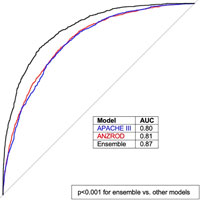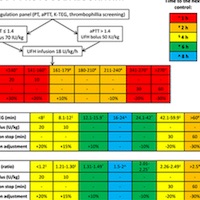Tag: study

Characterising Risk of In-Hospital Mortality Following Cardiac Arrest Using Machine Learning
Resuscitated cardiac arrest is associated with high mortality; however, the ability to estimate risk of adverse outcomes using existing illness severity scores is limited. Using in-hospital data available within the first... read more

Outcomes of Patients Presenting with Mild ARDS
Hospital mortality in acute respiratory distress syndrome (ARDS) is approximately 40%, but mortality and trajectory in "mild" acute respiratory distress syndrome (classified only since 2012) are unknown, and many cases are... read more

Are “Sniffer” Systems Effective in Detecting ARDS?
Acute respiratory distress syndrome (ARDS) results in substantial mortality but remains underdiagnosed in clinical practice. For this reason, automated "sniffer" systems that analyse electronic records have been developed... read more

Plasma mitochondrial DNA and metabolomic alterations in severe critical illness
Cell-free plasma mitochondrial DNA (mtDNA) levels are associated with endothelial dysfunction and differential outcomes in critical illness. A substantial alteration in metabolic homeostasis is commonly observed in severe... read more
Vitamin C: Should We Supplement?
A short course of intravenous vitamin C in pharmacological dose seems a promising, well tolerated, and cheap adjuvant therapy to modulate the overwhelming oxidative stress in severe sepsis, trauma, and reperfusion after ischemia.... read more

Cricoid Pressure in Airway Management: The IRIS Trial
This large randomized clinical trial performed in patients undergoing anesthesia with RSI failed to demonstrate the non-inferiority of the sham procedure in preventing pulmonary aspiration. Further studies are required in... read more

ICU Costs Higher for Patients Dying Before Discharge
The high cost of critical care has engendered research into identifying influential factors. However, previous studies have not considered patient vital status at ICU discharge. This is what a new study has found: The largest... read more

High-flow Nasal Cannula Oxygen Therapy for AHRF in Patients with CLD
A high-flow nasal cannula (HFNC) is a high-flow oxygen supply device developed in recent years and is increasingly being used to treat acute hypoxemic respiratory failure (AHRF) in intensive care unit (ICU). Patients with... read more

Thromboelastography-based Anticoagulation Management During ECMO
Thromboelastography (TEG) seems to be safely used to guide anticoagulation management during ECMO. Its use was associated with the administration of lower heparin doses compared to a standard of care aPTT-based protocol.... read more

Immediate interruption of sedation compared with usual sedation care in critically ill postoperative patients
This trial provides evidence that a strategy of avoiding continuous sedation as early as possible, in the absence of residual neuromuscular blockade and hypothermia, compared with usual sedation care, resulted in improvements... read more

Surfactant protein D is a causal risk factor for COPD
Surfactant protein D (SP-D) is produced primarily in the lung and is involved in regulating pulmonary surfactants, lipid homeostasis and innate immunity. Circulating SP-D levels in blood are associated with chronic obstructive... read more

Interventions to Improve the Physical Function of ICU Survivors
ICU admissions are ever increasing across the United States. Following critical illness, physical functioning (PF) may be impaired for up to 5 years. We performed a systematic review of randomized controlled trials evaluating... read more

The utility of biomarkers in traumatic brain injury clinical management
Currently, TBI management is guided by clinical histories and neuroimaging techniques. While these techniques may be advanced, they are more costly than serum analysis, involve exposure to ionizing radiations, and have certain... read more
What’s the Bleeding Problem with Trauma Laparotomies?!
Mortality for hypotensive trauma patients undergoing emergency laparotomy have not changed in 20 years. This blog explores the literature and the future! Wait! We're emergency physicians, why do we care about laparotomies?!... read more




